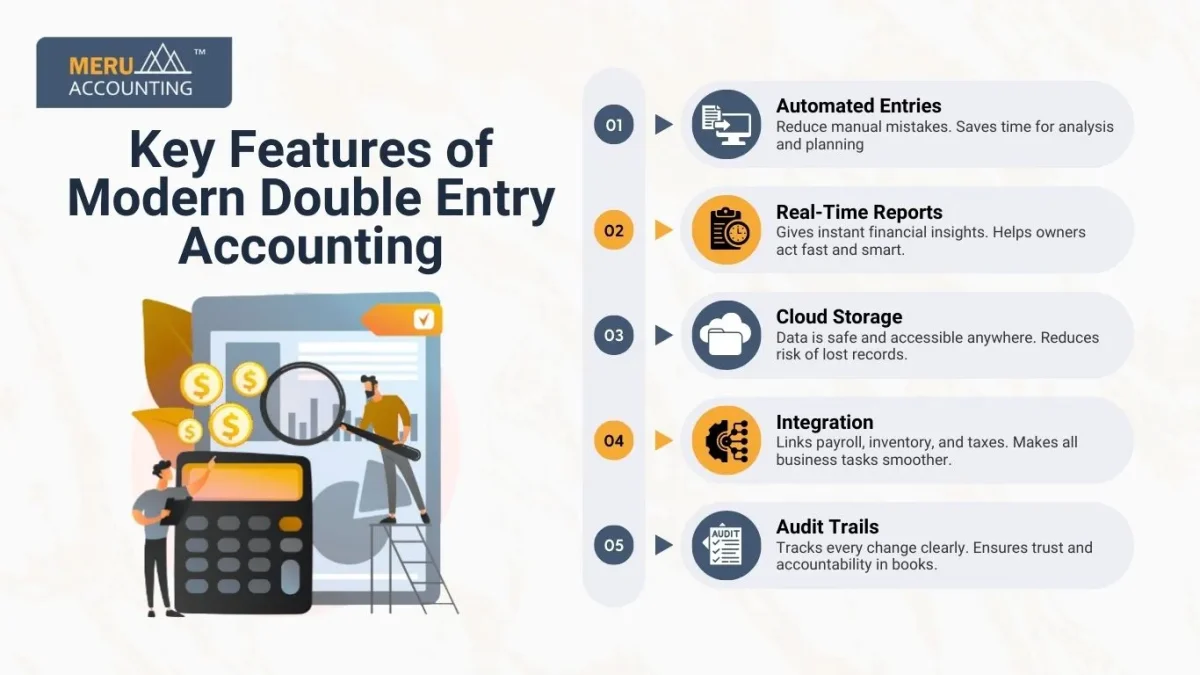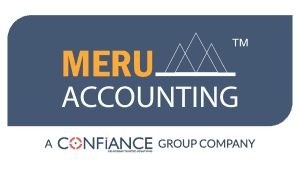Understanding Double-Entry Accounting and Its Application in Modern Accounting
Double-entry accounting is the main method for keeping books clear. It helps record all deals in a simple and balanced way. Each deal affects two accounts, one is debited, and one is credited. This method keeps books accurate and reduces errors. Businesses of all sizes use it to track cash and costs properly.
Double-entry accounting is very helpful in the modern business environment. It helps spot mistakes and prevents fraud in accounts. Modern accounting software uses this system to save time. Using this method gives owners clear reports to plan for growth. It also ensures tax rules are met and audits are easier.
What is Double Entry Accounting?
Double-entry accounting records every deal in two accounts. One account gains value, the other loses the same value. This keeps the books balanced.
Key Points:
- Each deal has two sides: debit and credit. This keeps the total of books even and correct.
- Helps keep all financial records accurate. Makes reports trustworthy and easy to read.
- Reduces mistakes and helps stop fraud. Any wrong entry can be found and fixed fast.
- Provides clear data for business choices. Owners can plan well using these reports.
How Double Entry Accounting Works
Double-entry accounting works by recording two entries for each deal. One account is debited, and one account is credited.
Example:
- Buying office supplies for $500:
- Debit: Office Supplies $500
- Credit: Cash $500
- Both accounts change, keeping books balanced.
- All deals are tracked, so nothing is missed.
Benefits:
Accuracy
Keeps entries checked and balanced.
Reduces the risk of wrong reports.
Transparency
Easy to see where money moves.
Helps staff and owners understand all accounts.
Error Detection
Mistakes are easier to spot.
Wrong entries can be corrected quickly.
Fraud Prevention
Helps find fake deals quickly.
Suspicious activity can be seen and stopped.
Importance of Double Entry Accounting in Modern Accounting
Double-entry accounting is key to proper money management. Businesses rely on it for correct records and decisions.
Benefits Include:
Better Control
Tracks every penny spent or earned.
Helps avoid overspending and stay within budgets.
Clear Reports
Makes income statements and balance sheets accurate.
Reports show the real status of business money.
Decision Support
Gives trustworthy data for choices.
Helps plan for growth and new projects.
Compliance
Follows tax and law rules easily.
Reduces fines and makes audits simple.
Modern accounting software uses Double-entry accounting to save time. Systems like Tally, QuickBooks, and Zoho Books rely on it.
Types of Accounts in Double-Entry Accounting
Double-entry accounting uses three main account types:
Personal Accounts
Related to people or companies.
Example: Debtors and creditors.
Tracks money owed to or from someone.
Real Accounts
Related to assets owned by the business.
Example: Cash, machinery, and buildings.
Tracks what the business owns or gains.
Nominal Accounts
Related to income and expenses.
Example: Salaries, rent, and sales revenue.
Helps track how money is earned or spent.
Rules of Double Entry Accounting
This system follows simple rules to record deals correctly.
Rules:
Personal Accounts
Debit the receiver, credit the giver.
Ensures money owed or given is correct.
Real Accounts
Debit what comes in, credit what goes out.
Tracks assets added or removed from the business.
Nominal Accounts
Debit all expenses, credit all incomes.
Shows how much is spent or earned.
Following rules keeps books balanced and reduces errors.
Advantages of Double Entry Accounting
Double-entry accounting has many benefits for businesses of all sizes.
Key Advantages:
- Error Reduction: Each deal has a matching entry. Mistakes can be seen and fixed fast.
- Financial Accuracy: Keeps all accounts balanced. Reports show the true state of business money.
- Fraud Prevention: Helps spot fake or wrong deals. Reduces losses caused by fraud.
- Better Planning: Gives insights for budgets and forecasts. Helps plan future projects with confidence.
- Easy Reporting: Prepares financial statements without stress. Makes audits quicker and easier for accountants.
Challenges in Double Entry Accounting
Even though effective, it has some challenges.
- Complexity: Can be hard for beginners. Requires practice to learn all the rules well.
- Time-Consuming: Manual entry takes longer. Mistakes may happen if not careful.
- Needs Training: Accountants must know the rules well. Wrong entries can cause confusion.
- Software Reliance: Many businesses use programs for ease. Software reduces mistakes but needs updates.
Despite these, the benefits of accuracy and trust outweigh the problems.
Double Entry Accounting in Modern Businesses
Modern businesses use this system in many ways.
Applications:
- Accounting Software: Tally, QuickBooks, and Zoho Books are used. Makes bookkeeping faster and simpler.
- ERP Systems: Link finance with sales and inventory. Ensures all departments have the correct data.
- Tax Preparation: Provides exact figures for taxes. Filing becomes simple and correct.
- Financial Analysis: Helps with ratios and budget planning. Shows where money is spent and earned.
- Digital Payments: Tracks bank and online transactions. Records every deal for clear accounts.
Businesses cannot run efficiently without this system.
Key Features of Modern Double Entry Accounting
Modern systems make double-entry Accounting easier.
Features:
- Automated Entries: Reduce manual mistakes. Saves time for analysis and planning.
- Real-Time Reports: Gives instant financial insights. Helps owners act fast and smart.
- Cloud Storage: Data is safe and accessible anywhere. Reduces risk of lost records.
- Integration: Links payroll, inventory, and taxes. Makes all business tasks smoother.
- Audit Trails: Tracks every change clearly. Ensures trust and accountability in books.

Tips for Effective Double Entry Accounting
Follow these tips for the best results.
- Keep Records Updated: Enter deals daily. Avoids backlog and errors in accounts.
- Use Software: Automate entries to save time. Reports are faster and more accurate.
- Follow Rules: Stick to debit and credit rules. Ensures books stay balanced and clear.
- Review Regularly: Check accounts often. Mistakes are corrected before reports are shared.
- Train Staff: Teach accountants all the rules. Reduces errors and ensures smooth accounting.
Common Mistakes in Double Entry Accounting
Even skilled staff can make mistakes in Double Entry Accounting.
Common Errors:
- Wrong Account Entry: Debiting or crediting the wrong account. This can make the books not balance.
- Missed Deals: Forgetting to record a transaction. Leads to wrong reports and poor decisions.
- Wrong Amounts: Entering the wrong sum in accounts. Causes reports to show false results.
- Duplicate Entries: Recording the same deal twice. Makes expenses or income look higher than real.
- Ignoring Rules: Not following debit and credit rules. Can make books unbalanced and confusing.
Role of Double Entry Accounting in Audits
Double-entry accounting helps make audits easy and quick.
Audit Benefits:
- Tracks all deals clearly for auditors. Shows where money comes from and goes.
- Makes it simple to check reports. Saves time and effort for the audit.
- Spots missing deals fast. Corrections can be made before final submission.
- Reduces risk of fines from mistakes. Shows business follows rules and laws.
- Builds trust with banks and investors. Clear books give confidence to partners.
Double Entry Accounting and Cash Flow Management
This system helps businesses watch cash closely.
Cash Flow Benefits:
- Shows money coming in and going out. Helps pay bills and salaries on time.
- Prevents cash shortages in the business. Keeps operations smooth and steady.
- Tracks loans and credit correctly. Avoids missing payments or extra charges.
- Helps plan for future spending. Owners can save for growth or projects.
- Gives data for short-term decisions. Supports daily and weekly money planning.
Using Double Entry Accounting with Software
Businesses now use software to ease double-entry accounting.
Software Benefits:
- Programs do entries automatically and reduce mistakes. Saves time for staff to focus on other work.
- Cloud tools let you check accounts anywhere. Owners can view books on mobile or PC.
- Links accounts with payroll, sales, and stock. Makes all records match across departments.
- Gives fast reports for decisions. Managers can act quickly using the correct data.
- Tracks online payments and digital deals. Books stay updated in real-time without errors.
Training and Skill Building in Double Entry Accounting
Good training improves work and reduces mistakes.
Training Tips:
- Learn debit and credit rules well. Knowing rules lowers errors in the books.
- Practice recording different types of deals. Experience builds confidence in handling accounts.
- Use accounting tools to practice. Combines manual skills with software skills.
- Join workshops and simple online courses. Keeps knowledge fresh and up-to-date.
- Review past errors to learn from them. Helps prevent mistakes in the future.
Industry Uses of Double Entry Accounting
Different businesses use Double Entry Accounting in their ways.
Applications:
- Shops and Retail: Tracks sales, stock, and costs. Helps avoid shortage or overspending.
- Services: Watches income and expenses closely. Ensures profit is calculated correctly.
- Factories: Tracks raw materials and production costs. Helps know the cost of finished goods.
- Hotels and Restaurants: Record bookings, bills, and payments. Keeps operations smooth and costs clear.
- Real Estate: Tracks rent, sales, and property costs. Helps manage many properties easily.
Future Trends in Double Entry Accounting
This system grows with business and simple tools.
Future Trends:
- Smart Tools: Can enter data and check errors. Reduces manual work and saves time.
- Cloud Books: Access accounts anywhere, anytime. Useful for remote teams and owners.
- Apps: Track money on mobile devices. Check accounts while on the go.
- Secure Ledgers: Use safe digital records. Helps trust in all account data.
- Forecasting: Use past deals to plan money. Helps with budgets and future growth.
How Businesses Gain from Double Entry Accounting
This system gives many real benefits for business.
Key Benefits:
- Keeps books correct and trustworthy. Owners can make choices with confidence.
- Helps plan budgets and track cash. Prevents overspending and money shortage.
- Supports the following laws and tax rules. Reduces risk of fines or audits.
- Gives insights for business growth. Helps managers focus on money-making areas.
- Works well with simple accounting tools. Saves time and reduces mistakes in books.
Double-entry accounting is key to accurate and clear financial records. It tracks every deal in two accounts to balance the books. Modern businesses rely on it for error-free reporting and clear insights. Using this system helps detect fraud and plan budgets well. It also makes tax filing easier and audits faster.
At Meru Accounting, we apply double-entry accounting to keep your books clear. Our team ensures all entries are correct and reports are reliable. We guide businesses in using software to automate tasks and save time. Partnering with Meru Accounting gives you peace of mind and correct financial records. Our experts provide trustworthy insights, helping owners make smart and confident business choices.
Double-entry accounting is a strong base for all modern businesses. Using it correctly ensures growth, trust, and smooth operations.
FAQs
- What is Double Entry Accounting?
It is a system where each deal has two entries. Keeps the books balanced and easy to check. - Why is it important?
It keeps accounts correct and reduces errors. Helps owners see the real money position. - What accounts are used?
Personal, real, and nominal accounts are used. Each tracks money differently for clarity. - Can small businesses use it?
Yes, it works for small businesses too. It helps track cash and costs clearly. - Is software needed?
Not needed, but it makes work faster. Manual entry is possible, but takes more effort. - How does it prevent fraud?
It tracks every deal with matching entries. Fake deals are easy to find quickly. - Does it help with taxes?
Yes, it gives correct data for filing. Reduces errors and audit issues.








